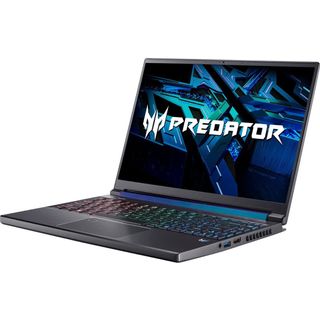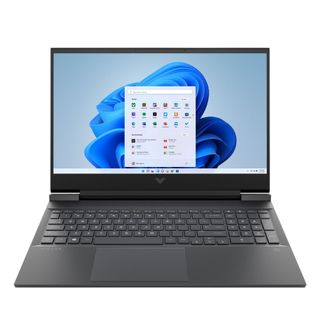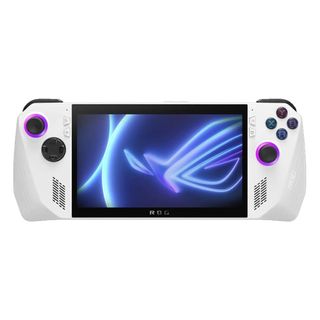The best cheap gaming laptops in 2024
The best cheap gaming laptops on the market

1. The list in brief ↴
2. Best overall
3. Best AMD
4. Best handheld gaming
5. How to find the right laptop
6. How we test
7. Why trust Laptop Mag
Budget gaming laptops must hit that sweet spot where affordability meets playability. Finding the best cheap gaming laptop can be a quest, but fear not, warriors! There are budget beasts out there waiting to unleash your inner gamer. Don't let the price tag fool you – these machines can handle VR worlds and AAA titles surprisingly smoothly. So ditch the wallet-crushing specs and embrace the budget brawl. Your next gaming adventure awaits!
And while the newest laptops with the more powerful components may be out of your budget, that doesn't mean you can't get a gaming laptop with last-gen specs, which are still plenty powerful (for a reasonable price).
We've compiled a list of the best cheap gaming laptops because we know gaming is an expensive hobby. Considering all the games and peripherals, it can get pricey fast. Thanks to the launch of Intel Core Ultra CPUs, new AI-infused chipsets from AMD, and the much anticipated Qualcomm Elite X, We should also see several sub $1,000 gaming laptops come out mid-year.
Over the course of a year, we review over 100 laptops, covering every price point and use case. When it comes to cheap gaming laptops, we evaluate a number of criteria, including gaming and overall performance, display, battery life, and, of course, value.
Whether you're looking for a gift for the gamer in your life or want an affordable way to frag on the go, here are the best cheap gaming laptops under $1,000.

Rami loves a great cheap gaming laptop. You shouldn't have to sacrifice everything outside of power just to be able to afford to game with your friends. Rami has spent a huge chunk of time reviewing dozens of the best cheap gaming laptops, and he can spot a cheap one from a well priced one. Extensive testing and hands-on experience has taught Rami how to ensure that you will get the most for what you're paying for.
The Quick List

Best overall
The Acer Predator Triton 300 SE is proof that you don’t have to choose between performance and affordability. The laptop delivers strong gaming and overall performance in a sleek 14-inch chassis.

Best AMD
With potent, perky specs, elegant design cues, and a solid FHD display t,he HP Victus 16 is an excellent entry-level gaming laptop that won’t deplete your bank account.
▼ Read more below

Best handheld gaming
The Asus ROG Ally is our favorite handheld gaming device. Its AMD Ryzen Z1 Extreme processor, comfortable ergonomic grip, and convenient Armoury Crate app make it feel snappy and powerful all at once.
The best cheap gaming laptops you can buy today
Why you can trust Laptop Mag
It's rough out here for cheap gaming laptops. Gaming laptops that cross over into the sub-$1,000 territory aren't always the best, and those that are can be a bit older than new models. You might notice that our list isn't long, but each cheap gaming laptop on this list belongs. These are the best cheap gaming laptops based on our extensive testing and hands-on experience.
Best overall





Specifications
Reasons to buy
Reasons to avoid
The Acer Predator Triton 300 SE debuted for over $1,000, but now it's in the best cheap gaming laptop range. When it initially launched, it was one of my favorite affordable gaming laptops. Now, it's a steal at its current price. This Predator is a 14-inch gaming laptop sporting a bright 1080p screen with a 144Hz refresh rate.
Yes, the Triton's RTX 3060 GPU is a slightly older model. Still, it consistently beat the average mainstream gaming laptops on AAA titles such as Shadow of the Tomb Raider and Assassin’s Creed Valhalla. During the Far Cry New Dawn benchmark, the Triton nailed 73 fps, which matched or beat the competition.
For a gaming laptop, the Predator Triton 300 SE offers decent battery life. It ran for 6 hours and 41 minutes on a single charge. It's not enough to get through a workday, but it'll last for at least two Avengers: Endgame rewatches.
Don’t count out its display, either. Packed with a 14-inch, 1080p at 144Hz display, the Predator Triton 300 clocked nearly 300 nits of brightness, which is remarkable for such an affordable laptop. It also covered 80.6 percent of the DCI-P3 color gamut — again, that’s more colorful than some laptops that cost thousands of dollars.
At this price point, we also expected to find a chunky 4~5-pound gaming laptop with a thick deck and thicker bezels. We didn’t get any of that. The Triton clocked in at 3.8 pounds and 12.7 x 9.0 x 0.7 inches. A gaming laptop that’s affordable and compact? Almost unheard of.
Between its size, performance, and battery life, the Acer Predator Triton 300 SE is the perfect laptop for gaming and bringing to work or school. It’ll last you a good while before you have to reach for a charger.
See our full Acer Predator Triton 300 SE review.
Best AMD





Specifications
Reasons to buy
Reasons to avoid
Awkward — we reviewed last year's version of the HP Victus 16, but this year's model offers a better deal and comes in a similar package. This HP Victus 16 offers an AMD Ryzen 7 7840HS processor, an Nvidia GeForce RTX 4060 GPU, 16GB of RAM, and a 1TB SSD.
We loved last year's HP Victus 16 for its office-like design and colorful 16-inch display, which this Victus seems to share if the specs are any indication. It also impressed us with its performance benchmarks, averaging 66 frames per second on the Borderlands 3 (Badass, 1080p) test.
The HP’s 16-inch, 1920 x 1080, 16:10 display also impressed us — that’s not the usual praise we’d give to a budget gaming laptop. It registered 75.2% of the DCI-P3 color gamut, which is decently colorful, but that’s not what struck us. It averaged 313 nits of brightness on our tests — enough brightness to combat well-lit spaces.
What I don’t see or hear enough of is great speakers. The HP Victus 16 doesn’t have that problem. Its Bang & Olufsen speakers excelled with a depth that captured highs, mids, and lows without a flicker of distortion. There’s not a lot of bass, mind you, but the HP Victus is one hell of a loud machine.
Where the HP Victus 16 plants a flag in my heart is the battery life. You get 7 hours and 26 minutes before you have to tether yourself to a wall. That’s almost enough time to finish an entire work or school day.
We can advocate for the HP Victus 16 we reviewed, and the latest model will likely land in the same place. However, we cannot guarantee that. What I can say is that it's a good deal.
See our full HP Victus 16 review.
Best handheld gaming





Specifications
Reasons to buy
Reasons to avoid
You're probably thinking, "this isn't a gaming laptop." Well, I'm here to tell you that it's arguably better. Handheld gaming devices are cheaper than your average gaming laptop and have quite a bit of power backing them.
The Asus ROG Ally is a classy entry into the handheld gaming scene post Steam Deck. One of your greatest advantages with the ROG Ally is the display. Yes, it's smaller than a gaming laptop, but it looks way better. The 7-inch, 1920 x 1080p AMD FreeSync touch panel sports a 7-millisecond response rate with a 120Hz refresh rate. It averaged 465 nits of brightness, brighter than some premium gaming laptops.
As far as performance goes, you won't play games on high settings, so put that out of your mind. But considering the size, the Ally pushed hard on our testing. For example, with Assassin’s Creed Valhalla, the ROG Ally scored 29 fps at 1080p on High. Turn that to low, and you'll likely get over 60 fps.
Regarding portability, the ROG Ally weighs only 21.4 ounces and measures 11 x 4.4 x 0.8 inches. You can practically throw this thing in a purse (I did). Unfortunately, its portability doesn’t extend to the battery life. Unlike the other products on this list, you’re getting 1 hour and 43 minutes — that is persistent gaming. If you’re not gaming, it lasts 5:51, but something tells me you won’t be using this Switch-like device for anything but.
The Asus ROG Ally may not be what you're looking for, but you should consider it between the price and what you get. This is great for controller-based gaming and playing on the go, whether on your daily commute or traveling across the skies.
See our full Asus ROG Ally review.
How to Choose One of the Best Cheap Gaming Laptops
When shopping for a gaming laptop, there's a lot to consider. We wrote a detailed piece about the nine most important factors. But to simplify the process of choosing a system, here are seven key points to keep in mind.
Budget: How we split cost categories
Money is getting tight. There was a time when you could find a good gaming laptop for under $1,000, but those are few and far between. If you're looking for a quality gaming laptop and are trying to budget yourself, try aiming for at least $1,300. But let's try to keep you under $1,000 to get the most out of your budget.
Remember that the bigger the GPU, the bigger the gaps in price points. So, list the games you play and start checking the PC requirements. Almost any gaming laptop with a 40-series GPU can play an indie game, but if you're dabbling in AAA titles, you have to decide which settings you're comfortable playing on.
Screen Size: 14 and 16 inches are the go-to
You'll rarely find a 13-inch gaming laptop nowadays, and 15.6-inch laptops have taken a backseat to the hyped-up 14-inch and 16-inch laptops. Those 17-inch gaming laptops also feel like a thing of the past. Well, now we have 18-inch gaming laptops. Yeah, they're beasts, but what all these sizes have in common is that they're getting more compact.
If you're looking for a gaming laptop to take on the go and even use as a school or work laptop, 14-inch gaming laptops are the perfect fit. Smaller gaming laptops also tend to have longer battery life. 16-inch gaming laptops are more manageable in size than 17- or 18-inch machines without sacrificing any power.
Under $1,000, you probably won't get an 18-inch powerhouse, but you can still get portable machines in the 14-inch category.
Screen Resolution: 1080p with high refresh rates or 1440p if you're lucky
Regarding gaming laptop displays, you want to balance frame rates and aesthetics. And if you're planning to get a truly mobile system, battery life also deserves consideration. A 1080p resolution is the bare minimum you'll find, which isn't great unless you're trading resolution for a high refresh rate. Panel makers now serve up screens with a 360Hz refresh rate and a three-millisecond response time, but you might not find that at this price range. Try to aim for 144Hz at least.
Forget about 4K screens, they're overpriced. However, you might be able to find a 1440p screen if you're lucky. And they usually offer at least a 120Hz refresh rate. Remember that laptops with lower resolutions tend to have longer battery life overall.
Refresh rate: 120Hz is a minimum
Depending on the kind of games you're playing, particularly first-person shooters and MOBAs, you'll take anything that enhances accuracy. Surprisingly, the higher a display's refresh rate is, the more accurate your shot becomes. We've experienced this firsthand during many demos. At this point, 60Hz is unacceptable for a gaming laptop (even if it's cheap), so we recommend investing in a panel with at least a 120Hz refresh rate.
You also have to balance graphics performance with resolution and refresh rate. Sometimes, a laptop is paired with a low-performing GPU and a high resolution and refresh rate. The math doesn't add up. If your gaming laptop cannot take advantage of the sharp screen or high refresh rate, then what's the point? Make sure you check the benchmarks.
Intel or AMD?
A couple of years ago, the answer to this question would have been undoubtedly Intel. However, AMD has made a furious comeback with its new Ryzen CPUs, which deliver outstanding overall performance and battery life. Thanks to the new Ryzen chips architecture, they're super power efficient without sacrificing productivity. The Ryzen 8000 series CPUs have consistently impressed with its performance versus battery life.
Not to be outdone, Intel's 14th-generation chips are nothing to sneeze at. Laptop manufacturers have started rolling out systems with Intel's Core Ultra chips. These chips are extremely powerful and are catching up to AMD with their battery life game.
Gaming laptops have been balancing performance with battery life, and it's changing the use case for these rigs for the better.
Battery Life: At least 5.5 hours
Unless it's plugged in, gaming laptop battery life tends to be very short, especially when gaming. However, the battery life of gaming laptops has increased over the years. So much so that anything under 5.5 hours is considered below average. We've reviewed several gaming laptops that last a whole workday and jump into the double digits. With results like that, we expect gaming laptops will match their non-gaming counterparts sooner rather than later. Our most recent power-efficient gaming laptop is the Razer Blade 14, lasting over 8 hours.
Specs: 1080p / Core i5 / 16GB are a minimum
You can spend a lot of time delving into specs, but here are the key components. If you want decent mainstream performance, go for a Core i5 CPU, 16GB of RAM, a 512GB SSD, and a 1080p screen.
How We Test the Best Cheap Gaming Laptops
When we bring a laptop into our laboratory, we aim to see how it would work if you brought it into your home or office. While we use industry-standard benchmarks such as Geekbench and 3DMark, we focus heavily on real-world tests that we have developed in-house.
To test endurance, the Laptop Mag Battery test surfs the web at 150 nits of brightness until the system runs out of juice. We use a giant spreadsheet macro that matches 65,000 names with their addresses to judge pure processing power, a video transcoder that converts a 4K video to 1080p, and the Geekbench 5/6 synthetic test.
We ramp up our 3DMark testing to also include Fire Strike Ultra and Time Spy Extreme, which determine how well the laptop copes with DX11 and DX12 4K graphics workloads. If the laptop is equipped with a graphics card that supports DirectX ray-tracing, we also use the 2560 x 1440 Port Royal test. (We don’t bother with Night Raid here—who cares about integrated graphics on a gaming laptop?) For the best-equipped laptops on the market, we may also run Speed Way, which plies the deepest and most demanding features of DX12 Ultimate.
We run all of gaming benchmarks in full-screen mode with vertical sync disabled, always at least at 1920 x 1080 (1080p) resolution, as well as the laptop's native resolution. Games include: Red Dead Redemption 2, Assassin's Creed Mirage, Shadow of the Tomb Raider, Borderlands 3, Far Cry 6, and more.
We use a colorimeter to measure screen brightness and color gamut, while other instruments help us determine a laptop's key travel and ambient heat. See this page on How We Test Laptops for more details on our benchmarking procedures.
Why Trust Laptop Mag
Laptop Mag reviews over one hundred different laptops every year, from paperweight ultralights to everyday workhorses to lumbering gaming notebooks that scorch the frame rates of even the hottest AAA games. We're not just experts in the laptop field, as we go one step further by meticulously testing smartphones, tablets, headphones, PC accessories, software, and even the latest in gaming.
We are 100% independent and have decades of experience to help you buy with confidence. In fact, Laptop Mag has been testing and reviewing products for three decades, and we continue to deliver trustworthy reviews you can rely on.
Our experienced team of writers and editors scour the available information about the laptop and put it through its paces to determine which is best for you. But before they start, the testing team subjects each system to a rigorous regimen of synthetic and real-world tests to see how a system handles the type of work and games you’re most likely to throw at it.
Our editorial trustworthiness is enforced by one of the world's largest technology publishers, Future Publishing. As a company, we have unrivaled experience across every tech sector — and we're the group's specialist for all things mobile tech.
Stay in the know with Laptop Mag
Get our in-depth reviews, helpful tips, great deals, and the biggest news stories delivered to your inbox.

Rami Tabari is an Editor for Laptop Mag. He reviews every shape and form of a laptop as well as all sorts of cool tech. You can find him sitting at his desk surrounded by a hoarder's dream of laptops, and when he navigates his way out to civilization, you can catch him watching really bad anime or playing some kind of painfully difficult game. He’s the best at every game and he just doesn’t lose. That’s why you’ll occasionally catch his byline attached to the latest Souls-like challenge.